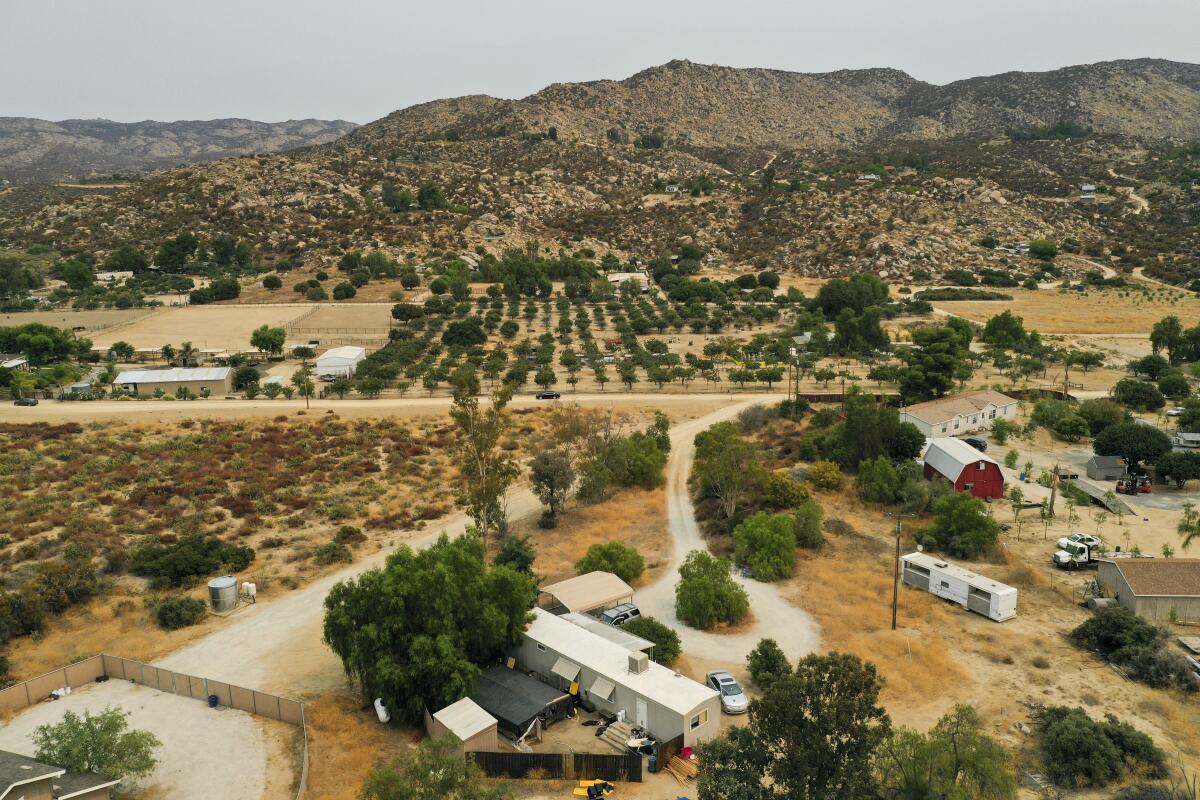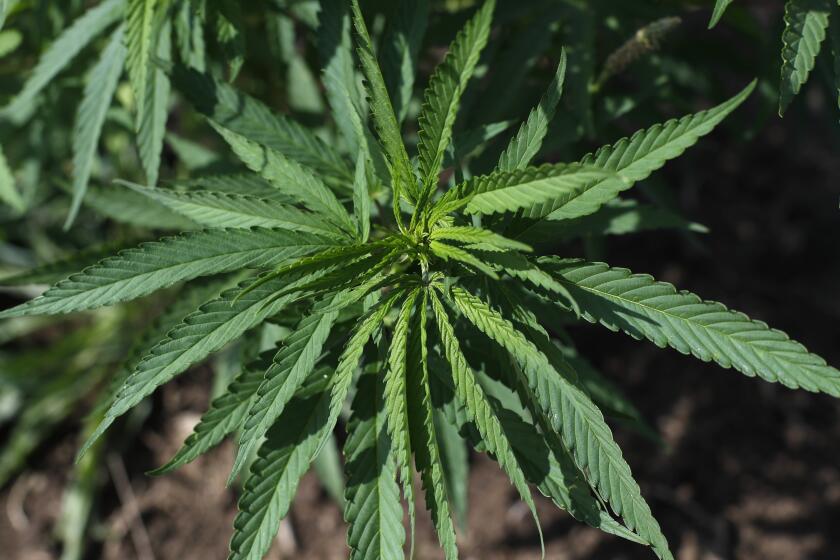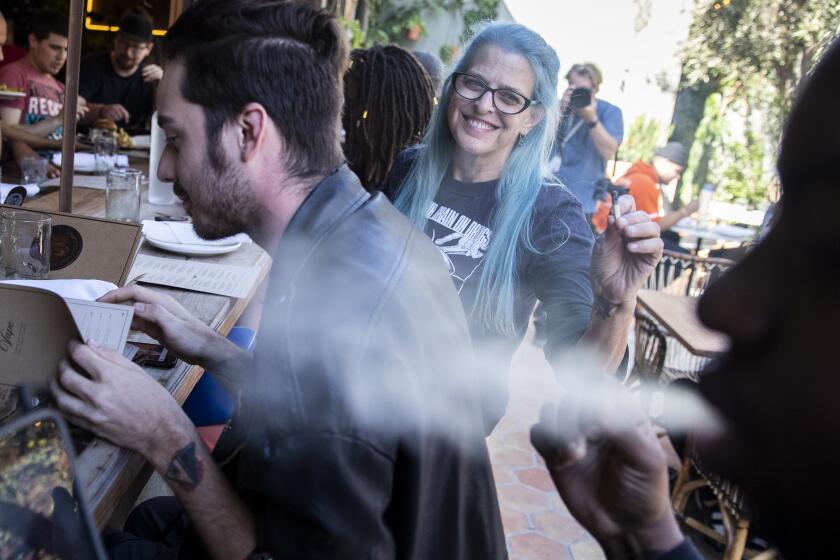Seven bodies, nothing stolen: Were killings at Riverside marijuana grow ‘a message’?

ANZA, Calif. — The boy knew how his mother made a living. He also knew the danger inherent in it.
As recently as two months ago, he had stayed at a property in Aguanga, a small community in rural Riverside County, where his mother, helped by recent immigrants from Laos, grew marijuana.
By day, he watered the plants and lugged buckets full of soil and supplements that helped them grow; by night, he slept on a small cot in a trailer alongside his mother, her boyfriend and her friend.
Though he did not think his mother growing marijuana made her a bad person, the 16-year-old recalled an unease, the sense that violence could at any moment intrude on that dusty, far-flung property.
“It’s drugs,” he said. “And anything can happen when you’re dealing drugs.”
Half an hour after midnight on Sept. 7, Riverside sheriff’s deputies were called to the property, where they found a woman badly shot and in the last hours of her life. She would die at a local hospital. Elsewhere on the site, the deputies found the bodies of six people, all of them shot to death. The boy’s mother, Phone Chankhamany, was among the dead.
One month later, Riverside County’s worst mass killing in recent memory remains cloaked in mystery. The authorities have not said if they’ve turned up a motive or narrowed in on any suspects. The Riverside Sheriff’s Department has declined requests for interviews and placed security holds on the coroner’s reports, blocking their disclosure.
The victims — who, according to Chankhamany’s son, were mostly new immigrants from Laos — have little if any paper trail. No property records, court cases or other public documents that might offer insight into their lives or leads to relatives who could.
Yet what facts have emerged illustrate a brutal point: Violence haunts California’s illegal marijuana market, which, law enforcement authorities concede, dwarfs its fledgling, legal counterpart and comprises a sweeping array of players, from mom-and-pop grows to sophisticated drug trafficking organizations.
The murder scene in Aguanga was a large marijuana cultivation and processing site — a “major organized-crime type of an operation,” Sheriff Chad Bianco said. Everyone on the property — living and dead — was Laotian.
The dead were five women, ages 44 to 59, and two men, 53 and 64. In addition to Chankhamany, 54, their names were Souphanh Pienthiene, Thongpath Luangkoth, Samantha Sourignasak, Khamphour Nanthavongdovane, and Vikham and Khamtoune Silimanotham.
Chankhamany’s son, whom The Times is not naming for his safety, said his mother had overseen the grow. She was born in Laos and came to the United States about 16 years ago, he said in an interview at his uncle’s home.
Several of his mother’s friends worked at the grow, he said, alongside a revolving cast of recent immigrants from Laos, who, unable to speak English and struggling to find employment, would work and live on the site until they made enough cash to move on.
“Usually, when they come to the U.S., it’s the first thing they do to make money,” he said.
About 20 people were living on the Aguanga property, the sheriff said. Some had stayed in a beige, two-story house on whose front door was taped a handwritten note that read in English, “Welcome to our home, please take your shoe off before enter the house,” and a similar message beneath it in Lao. Others slept in tents and a trailer.
A day after the shootings, Bianco said his detectives were pursuing the theory that multiple assailants had carried them out. If that theory has changed, the Sheriff’s Department will not say.
Wade Shannon, assistant special agent in charge of the Drug Enforcement Administration’s operations in Riverside and San Bernardino counties, noted the slayings came during peak harvest time, yet there was no sign the site had been robbed. “This wasn’t a rip-off,” he said in an interview. “If you’re not robbing someone, you’re sending a message.”
Shannon theorized the growers were either operating in someone’s territory or eating into someone’s profits. “This was sending a message. The question is: Who did it?”
To consider who might have carried out the murders, consider where they took place: the Anza Valley, a longtime hub for marijuana cultivation, and beyond that, the Inland Empire, which Shannon described as “ground zero for drug trafficking in the United States.”
The region is favored by drug traffickers for the same reason it is favored by shipping companies: Interstates and other major thoroughfares weave through it, leading to various distribution points across the country. Huge truck yards in Rialto, Colton and Fontana offer a pool of potential couriers, and the U.S.-Mexican border — across, over and beneath which drugs and the proceeds of their sale flow — is not far away.
Yet unlike other drugs such as methamphetamine, which is typically synthesized in “super-labs” in Mexico and smuggled north, much of the marijuana coursing out of the Inland Empire is homegrown, Shannon said.
Marijuana is bulkier than other drugs and more difficult to secrete in a cross-border shipment. “If you’re wearing baggy pants, you can hide a pound of meth in your pocket,” he said. “Marijuana, not so much.” For this reason, many drug traffickers prefer growing marijuana in the United States to raising it elsewhere and trying to slip it into the country.
Shannon divided the region’s illegal marijuana cultivators into three loose groups, each with a distinct modus operandi. Chinese nationals, he said, have set up sophisticated grows within suburban rental homes. They typically divert electricity before it reaches the meter and use it to power high-wattage grow lights and irrigation systems, he said.
They will grow inside a rental home for a few years, then abandon it. By that time, Shannon said, the house is all but ruined by the humidity, which breeds mold, and the reek of marijuana, which seeps into the drywall.
Mexican drug trafficking groups, Shannon said, oversee the largest cultivation sites in the Inland Empire — fields that are carved out of public forest land, tended by low-paid laborers, irrigated with water siphoned from public sources and doused in illegal pesticides that can poison groundwater. A bonus of growing marijuana on public land, he added, is that if the operators are prosecuted and their property subject to forfeiture, the government cannot seize the land because it already owns it.
The third group in the Inland Empire are Laotian growers, Shannon said. Concentrated in the Anza Valley, they typically raise their crop in plywood sheds and grow houses erected on private land.
At the scene in Aguanga where seven people were slain, deputies found a crude, wooden grow house covered with a black tarp, as well as a lab used to extract THC from marijuana plants. They recovered more than 1,000 pounds of processed marijuana, valued in the millions, the sheriff said.
Chankhamany’s son said he never learned to whom his mother sold her crop, although she once mentioned driving a load down to Tijuana. She was in this business solely to make money, he said. “She’s not a bad person. It was weed — it wasn’t like it was hardcore meth.”
Though his mother lived in the Temecula area and he in a different state, she called every day, he said, to ask how his day had gone and what he’d eaten. “She always said she loved me before she hung up,” he remembered.
This summer, after finishing his freshman year of high school, he stayed with his mother in Aguanga, helping tend her crop from mid-July through the first week of August. He would have stayed longer, he said, had some friends from school not convinced him to return for a birthday.
“If I was still there,” he said slowly, “I don’t know what would have happened.”
The boy recalled that two or three years ago, he noticed several faces were absent from the grow, faces of people he believed were business partners of his mother. When he asked about them, she said, “They’re not friends anymore.”
He sensed they had not parted on good terms. Now, when he wonders who could have killed his mother, he revisits that exchange, those faces.
“I don’t think it was a robbery,” he said. “I think it was someone who didn’t like my mom.”
More to Read
Sign up for Essential California
The most important California stories and recommendations in your inbox every morning.
You may occasionally receive promotional content from the Los Angeles Times.










